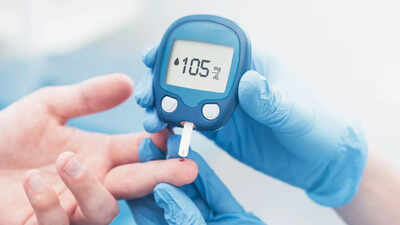For individuals managing diabetes, maintaining stable blood sugar levels is a continuous effort. A frequent challenge is encountering unexpectedly high blood glucose levels upon waking. This occurrence is often linked to the "Dawn Phenomenon," a natural process where blood glucose levels rise in the early morning.

Accurate measurement of morning glucose is crucial for adapting management strategies, which include adjustments to medication, diet, and lifestyle. Understanding your body's specific patterns and responses can help you develop effective strategies for tackling high blood sugar levels. This might involve modifying medication dosages, dietary choices, or exercise routines. Taking a proactive approach to managing your diabetes is key to achieving optimal blood sugar control and improving overall health.
Blood sugar, or blood glucose, refers to the amount of glucose (sugar) in the blood. Glucose is the body's primary energy source for its cells. Blood sugar levels naturally increase in the early morning due to the release of hormones like cortisol and growth hormone. This increase is known as the "Dawn Phenomenon."
The dawn phenomenon is a natural process in people with diabetes, marked by increased blood sugar (glucose) levels during the early morning hours, typically between 4 a.m. and 8 a.m. Studies suggest that it affects over 50% of individuals with Type 1 or Type 2 diabetes.
Monitoring blood sugar levels, particularly in the morning, is vital. It helps tailor personalized management plans, enabling adjustments to:
According to the American Diabetes Association, reduced insulin activity is a primary cause of high blood sugar. Between 3 a.m. and 8 a.m., the body releases hormones like cortisol and growth hormone, prompting the liver to increase glucose production to provide energy for waking up.
However, in individuals with diabetes:
Consequently, blood sugar levels increase, leading to high morning blood sugar readings.
The main sign of the dawn phenomenon is elevated blood sugar levels in the morning, usually detected through glucometer readings or continuous glucose monitoring (CGM) devices. If blood sugar levels are significantly high, common symptoms may include:
The most reliable way to detect the dawn phenomenon is using continuous glucose monitoring (CGM), which tracks glucose levels continuously. A CGM device measures glucose levels every few minutes, creating a graph that shows blood sugar patterns over time. Without CGM, healthcare providers can still identify the dawn phenomenon by analyzing patterns of consistent glucometer readings. This provides a detailed view of glucose fluctuations, helping to:
If unmanaged, the dawn phenomenon can cause consistently high blood sugar levels, increasing the risk of diabetes complications, including:
Failure to address the dawn phenomenon can lead to extended periods of high blood sugar, ultimately impacting long-term health.
Certain lifestyle changes and home remedies may help lower morning blood sugar levels:
If you experience high blood glucose levels frequently (more than three times in 2 weeks), consulting a doctor is advisable. Individuals with diabetes should consult their doctor before trying any home remedies or making changes to medication for personalized advice.
The timing of blood sugar tests is important, as blood sugar levels can fluctuate after carbohydrate consumption. Recommended testing times include:
To manage blood sugar spikes related to the dawn phenomenon, individuals with diabetes can try the following strategies:
If elevated morning blood sugar levels persist, consult a doctor for individualized advice. Staying consistent with your routine and regularly following up with your healthcare provider can significantly reduce the risk of complications associated with the dawn phenomenon.
Newer articles
Older articles
 Samsung Galaxy A35 5G and A55 5G: Full Pricing and Specs Revealed
Samsung Galaxy A35 5G and A55 5G: Full Pricing and Specs Revealed
 Warning Signs: 5 Clues Your Body May Be Signaling Prediabetes
Warning Signs: 5 Clues Your Body May Be Signaling Prediabetes
 SA20 Teams Allowed Up to Six Player Retentions, Enhanced by New RTM Card and Increased Salary Cap for Upcoming Auction
SA20 Teams Allowed Up to Six Player Retentions, Enhanced by New RTM Card and Increased Salary Cap for Upcoming Auction
 Brain's Eye View: Study Shows We See the World 15 Seconds in the Past
OR
The 15-Second Delay: How Your Brain Creates a Seamless, But Delayed, Reality
Brain's Eye View: Study Shows We See the World 15 Seconds in the Past
OR
The 15-Second Delay: How Your Brain Creates a Seamless, But Delayed, Reality
 Expert Tips to Help Kids Sharpen Focus and Combat Distractions
Expert Tips to Help Kids Sharpen Focus and Combat Distractions
 Cervical Cancer: Don't Ignore These 5 Subtle Warning Signs
Cervical Cancer: Don't Ignore These 5 Subtle Warning Signs
 Science-Backed: 5 Simple Daily Habits for a Healthier Heart
Science-Backed: 5 Simple Daily Habits for a Healthier Heart
 Shimron Hetmyer's Last-Gasp Six Stuns MI New York, Orcas Complete Record MLC Chase
Shimron Hetmyer's Last-Gasp Six Stuns MI New York, Orcas Complete Record MLC Chase
 Oral Cancer: Spotting the Signs, Understanding the Risks, and Why Early Detection is Critical
Oral Cancer: Spotting the Signs, Understanding the Risks, and Why Early Detection is Critical
 Infrequent Bowel Movements: When Is It Time to Worry? A Guide to Healthy Digestion
Infrequent Bowel Movements: When Is It Time to Worry? A Guide to Healthy Digestion